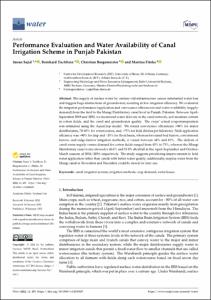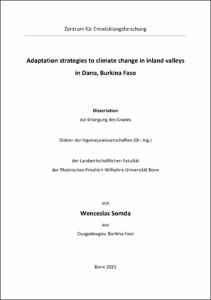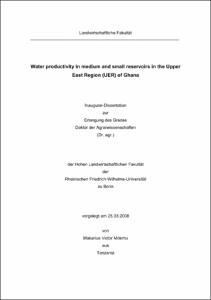Sajid, Imran: Options to improve irrigation efficiency and productivity under rotational delivery schedule, a bottom-up approach applied at canal irrigation scheme in Pakistan. - Bonn, 2022. - Dissertation, Rheinische Friedrich-Wilhelms-Universität Bonn.
Online-Ausgabe in bonndoc: https://nbn-resolving.org/urn:nbn:de:hbz:5-68767
Online-Ausgabe in bonndoc: https://nbn-resolving.org/urn:nbn:de:hbz:5-68767
@phdthesis{handle:20.500.11811/10505,
urn: https://nbn-resolving.org/urn:nbn:de:hbz:5-68767,
author = {{Imran Sajid}},
title = {Options to improve irrigation efficiency and productivity under rotational delivery schedule, a bottom-up approach applied at canal irrigation scheme in Pakistan},
school = {Rheinische Friedrich-Wilhelms-Universität Bonn},
year = 2022,
month = dec,
note = {In Punjab, Pakistan, the Warabandi principle guides the distribution of surface water over a network of canals providing farmers with limited water in proportion to land size in a fixed 7-days rotation. Current problems with the irrigation performance include rigid rotation and limited supply of water by century-old infrastructure under the Warabandi principle causing substantial water losses and triggering huge abstractions of groundwater by farmers, resulting in low irrigation efficiency and productivity while endangering the aquifer in terms of quantity and quality.
This thesis suggests the introduction of more flexible and site-specific irrigation scheduling in a bottom-up approach starting from the farm level as an entry point for complementing the perspective of a top-down approach in managing the Warabandi large-scale water allocation. The domain of this thesis discusses four specific objectives. The first objective consists in assessing the performance of canal irrigation scheme and water availability, while the second aim was to evaluate cotton irrigation scheduling in the context of Warabandi under various cultivation methods. The competence of several irrigation scheduling scenarios for cotton was investigated under the third objective, and the fourth particular objective addressed a barriers assessment in a potential implementation of proposed water management interventions.
This thesis considered a data and model-driven approach. Between June 2019 to October 2020, water delivery in the canal network was monitored and six cotton fields were randomly selected in the Mungi Distributary canal command area in Punjab. Each field's cotton cropping season activities were monitored and measured. The AquaCrop model was calibrated and validated separately for each field, and then applied to quantify four irrigation scheduling scenarios for two fields. Scenario 1 reflects the current irrigation practice in the canal and groundwater use, while for scenarios 2, 3, and 4, solely Warabandi canal water allowance was considered and irrigation followed a fixed rotation of 7-days, 14-days, and flexible intervals, respectively. Moreover, three groups of stakeholders were individually interviewed using a structured questionnaire during September-December 2020: (a) 72 farmers, (b) 15 officials, and (c) 14 academicians.
The analysis under the first objective revealed a conveyance efficiency of ~75% for the network of canals, while field application efficiency was estimated as ~64% that led to overall Mungi canal irrigation scheme efficiency of 48%. The deficits of canal water supply versus demand for six cotton fields ranged from 45% to 73%, whereas the Mungi Distributary canal water showed a 68.6% and 19.8% shortfall in the April–September (Kharif) and October–March (Rabi) seasons of 2018/2019, respectively. Considering the outcome of the second objective, a farmer using drip technique attained the highest gross water productivity (GWP) 1.13 (kg raw cotton yield/m)3 gross water applied. In contrast, the raised-bed furrow cultivator obtained the lowest GWP of 0.23 kg/m3, respectively. While the GWP varied between 0.25 and 0.39 kg/m3 for flood basin, another field of raised-bed furrow, and two ridge-furrow cultivation methods. Moreover, the findings of the third objective unveiled that scenarios 2, 3, and 4 resulted in a substantial reduction of percolation water below the crop’s root zone and lowered actual evaporation enabling similar yields and higher gross water productivity compared to the current practices in both fields using raised-bed furrow cultivation methods. The fourth objective’s evaluation reflected that the most important barriers in the adaptation of the water management interventions (on-farm water storage, soil moisture sensor and drip) that were highly rated by the participants of the groups were low awareness, lack of training and financial resources. While the main problems in canal water distribution provisions were expressed by the farmers as limited canal water allocation, academicians were concerned mostly with inflexibility and officials conveyed discussion among neighbors. This thesis provided new on-farm water optimization options that could contribute to ensuring that cotton farming transforms sustainable in Pakistan.},
url = {https://hdl.handle.net/20.500.11811/10505}
}
urn: https://nbn-resolving.org/urn:nbn:de:hbz:5-68767,
author = {{Imran Sajid}},
title = {Options to improve irrigation efficiency and productivity under rotational delivery schedule, a bottom-up approach applied at canal irrigation scheme in Pakistan},
school = {Rheinische Friedrich-Wilhelms-Universität Bonn},
year = 2022,
month = dec,
note = {In Punjab, Pakistan, the Warabandi principle guides the distribution of surface water over a network of canals providing farmers with limited water in proportion to land size in a fixed 7-days rotation. Current problems with the irrigation performance include rigid rotation and limited supply of water by century-old infrastructure under the Warabandi principle causing substantial water losses and triggering huge abstractions of groundwater by farmers, resulting in low irrigation efficiency and productivity while endangering the aquifer in terms of quantity and quality.
This thesis suggests the introduction of more flexible and site-specific irrigation scheduling in a bottom-up approach starting from the farm level as an entry point for complementing the perspective of a top-down approach in managing the Warabandi large-scale water allocation. The domain of this thesis discusses four specific objectives. The first objective consists in assessing the performance of canal irrigation scheme and water availability, while the second aim was to evaluate cotton irrigation scheduling in the context of Warabandi under various cultivation methods. The competence of several irrigation scheduling scenarios for cotton was investigated under the third objective, and the fourth particular objective addressed a barriers assessment in a potential implementation of proposed water management interventions.
This thesis considered a data and model-driven approach. Between June 2019 to October 2020, water delivery in the canal network was monitored and six cotton fields were randomly selected in the Mungi Distributary canal command area in Punjab. Each field's cotton cropping season activities were monitored and measured. The AquaCrop model was calibrated and validated separately for each field, and then applied to quantify four irrigation scheduling scenarios for two fields. Scenario 1 reflects the current irrigation practice in the canal and groundwater use, while for scenarios 2, 3, and 4, solely Warabandi canal water allowance was considered and irrigation followed a fixed rotation of 7-days, 14-days, and flexible intervals, respectively. Moreover, three groups of stakeholders were individually interviewed using a structured questionnaire during September-December 2020: (a) 72 farmers, (b) 15 officials, and (c) 14 academicians.
The analysis under the first objective revealed a conveyance efficiency of ~75% for the network of canals, while field application efficiency was estimated as ~64% that led to overall Mungi canal irrigation scheme efficiency of 48%. The deficits of canal water supply versus demand for six cotton fields ranged from 45% to 73%, whereas the Mungi Distributary canal water showed a 68.6% and 19.8% shortfall in the April–September (Kharif) and October–March (Rabi) seasons of 2018/2019, respectively. Considering the outcome of the second objective, a farmer using drip technique attained the highest gross water productivity (GWP) 1.13 (kg raw cotton yield/m)3 gross water applied. In contrast, the raised-bed furrow cultivator obtained the lowest GWP of 0.23 kg/m3, respectively. While the GWP varied between 0.25 and 0.39 kg/m3 for flood basin, another field of raised-bed furrow, and two ridge-furrow cultivation methods. Moreover, the findings of the third objective unveiled that scenarios 2, 3, and 4 resulted in a substantial reduction of percolation water below the crop’s root zone and lowered actual evaporation enabling similar yields and higher gross water productivity compared to the current practices in both fields using raised-bed furrow cultivation methods. The fourth objective’s evaluation reflected that the most important barriers in the adaptation of the water management interventions (on-farm water storage, soil moisture sensor and drip) that were highly rated by the participants of the groups were low awareness, lack of training and financial resources. While the main problems in canal water distribution provisions were expressed by the farmers as limited canal water allocation, academicians were concerned mostly with inflexibility and officials conveyed discussion among neighbors. This thesis provided new on-farm water optimization options that could contribute to ensuring that cotton farming transforms sustainable in Pakistan.},
url = {https://hdl.handle.net/20.500.11811/10505}
}









